Rolandt
Shared posts
Why the Horrid 'Keep Calm and Carry On' Meme Still Won't Die - Vice
Weeknote 08/2016 (warning: may contain gifs and emojis)
I’m going to eschew the usual bullet-point list this week for more of a reflective narrative. Well, it’s my blog and I get to make up the rules. So there.

I’ve just been explaining to my children the difference between mechanical and electronic typewriters, and then typewriters vs. computers. Hence the gif. I’m pretty sure they think I type things and travel on trains for a living.
This week, Dai and I couldn’t find a mutually-convenient time to record an episode of our Today In Digital Education (TIDE) podcast. That’s probably a good thing as, at almost two hours each, it gives our audience to catch up with previous episodes! ⌛
My newsletter last week featured, amongst other things, IPFS, Mars (the planet) and octopus sex. I also write a monthly Dynamic Skillset newsletter and thinking of switching from MailChimp to Revue for that. I’ll be sending out the latest issue of both my newsletters this weekend, so if you don’t yet subscribe, well you should get that sorted out before reading any further.

It’s been a great week. Every year I’m basically in hibernation mode between Autumn and Spring half-terms; my body clock seems to be a curious mix of the rhythms of the academic year, coupled with some kind of primordial tendency towards hibernation as the nights get darker. So yes, from now for the next eight months I’m SUPER DOUG. ✊
I’ve been to London as usual this week but only spent a day and a half working for City & Guilds while I was down there (I did the other half a day for them working from home). The reason for that deviation from the norm was to do some thinking with Bryan Mathers and Eylan Ezekiel about the future of Dynamic Skillset. I’ve written up the mini Thinkathon we did here.
It was the Digital Careers Show North London this week, and City & Guilds were a Platinum sponsor, so I found myself hanging out there and talking to various people before the Ufi/MOBILIZE:LDN/Wayra networking event in the evening. It was good to catch up with Sarah Simons, Erica Neve, Arfah Farooq, and others.

Wearing multiple hats as I do, it’s sometimes difficult to know which one you’re wearing at any given time. I’m fairly sure I had every hat on when meeting the wonderful Sarah Drummond and Anne Dhir from Snook. I’m a big fan. They’re looking for a Moodle developer for a badge-related project so, you know, if you know someone talented and fast-working point them here. 
In other news, I was asked to speak in South Africa in May, a big-name client wants some follow-up work, and there’s another one in the offing. All in a week when I got a lot more clarity about the direction I want to take things. Oh, and I wrote something about why the way we hire people is completely broken, and suggested some ways to fix it.
I had quite a lot to get through this week, so I only got half a ‘Doug day’. I spent Friday morning walking to Beacon Hill, which is about five miles away from my house. It’s quite an interesting history. On the way, I found a World War II shelter, had to sneak over the new bypass being built (the footpath was officially closed), and got pretty muddy making my way through fields.

Right, that’s about enough. I’ll probably revert to bullet points next week. It’s quicker for me and it means you don’t have to deal with my insufferable prose. Enjoy the rest of your weekend! ⛱
Need some help untangling knotty problems? In identifying, developing, and/or credentialing digital skills? Just want some quick advice on edtech stuff? Get in touch!
Why the Horrid 'Keep Calm and Carry On' Meme Still Won't Die - Vice
The saddest job of the IT world is … being a growth hacker
I held my second growth hacking workshop for StartupYard a few days ago and I did a small research – I was looking for a joke to use as an icebreaker at the start of the workshop. So I was trying to find out some funny growth hacking resources using Google, but then I realized, […]
The post The saddest job of the IT world is … being a growth hacker appeared first on Bogomil Shopov.
Nissan Leaf's Naked APIs
 This week the popular Nissan Leaf was in the headlines, but not in a good way. Security researchers Scott Helme and Troy Hunt demonstrated how any Leaf can be easily hacked. The duo hacked into Helme’s Leaf with little more than its vehicle identification number, as described on Hunt’s blog.
This week the popular Nissan Leaf was in the headlines, but not in a good way. Security researchers Scott Helme and Troy Hunt demonstrated how any Leaf can be easily hacked. The duo hacked into Helme’s Leaf with little more than its vehicle identification number, as described on Hunt’s blog.
In Nissan’s case, shortcuts taken on API infrastructure produced a very bad outcome, and raises a lot of questions. What’s the brand damage to Leaf and Nissan? How much customer trust and goodwill has been lost? How much employee time will be squandered fixing the problem, answering questions, doing root cause analysis, reviewing procedures, assigning blame, and dealing with lawyers?
On the one hand you have to applaud Nissan. Car owners want the convenience of being able to control and monitor car functions via their mobile devices and Nissan built an app for Leaf owners—the company is executing a digital strategy.
On the other hand, clearly anyone providing a mobile app needs to think about securing the underlying APIs that app is built on! Building an app on naked APIs is hardly a sound strategy.
If you provide APIs for consumer experiences, you should ask yourself:
- How do you protect your backend from misuse and abuse?
- How do you identify clients? Authenticate and authorize use?
- What kind of rate limiting do you need? How do you prevent your system from being overrun?
- Do you have visibility into your API traffic and usage?
- Can you quickly detect automated (bot) attacks on your APIs—and stop them?
There’s a lot to consider, and if you have multiple APIs (the average app uses six) you have to ensure that you have visibility, control, and security across all of them.
Who owns API security, and how much is enough? Join the conversation on the Apigee Community.
Counting Sheep
It turns out, there have been nerds for a very long time.
I'm reading Bloody Mary’s, Geoffrey Dennis’s 1934 account of being a British schoolboy in the 1890s.
There's a diversion about Special Local Knowledge that all the boys acquire from each other at school, and one of their fascinations is that, even in the 1890s, Yorkshire shepherds had a separate system for "scoring" sheep. (Scoring, I presume, because you want to know how many score of sheep you have, rather than to know whether the sheep are winning.) The numbers are:
Yah, Tiah, Tethera, Methera, Pip,
Seezar, Leezer, Cattera, Hona, Dick,
Yah-Dick, Tiah-Dick, Tether-a-Dick, Mether-a-Dick, Bumper,
Yah-De-Bumper, Tiah-de-Bumper, Tether-de-Bumper, Mether-de-Bumper, Jigger.
So sheep #5 is Pip, #10 is Dick, #15 is Bumper, and #20 is Jigger. Is that why Jack Aubrey calls a full glass (“A toast! Bumpers all round!”) a bumper? They’re not all nonsense words, either; "pip" is apparently derived from Welsh pump. It’s not just one mad farmer’s habit, either; variants of the system have been collected from Yorkshire, Ireland, and (!) Ohio.
See also costermonger’s back-talk, which is not the sort of back-talk your mother warned you against.
Update: I am informed that school boys today still revel in these counting systems. Can’t blame them. Also, a variant of “Cattera, Hona, Dick” – eight, nine, ten – is, apparently, “Hickory, Dickory, Dock”, which everyone knows, and especially the mouse.
Slavoj Žižek on Objects
Slavoj Žižek,
Mariborchan,
Feb 29, 2016
So here's a question for you: is a dog a certain type of object that has a certain set of properties? Or is a dog some object that has, among other properties, the property of 'being a dog'? In other words: do we know what properties a thing has if we know what type of thing the thing is? Or do know what type of thing we have if we know what properties the thing has? A lot hangs on this question. The former is the cornerstone of object oriented program. The latter? It's not so clear; whoever heard of a dataset without any semantics? Well, me, for one.
There's a history to this argument. We can think of the two views as 'semantic' and 'post-semantic', or 'structural' and 'post-structural'. Perhaps 'Saussurian' and 'Lacancian'. But in the end, it means I'm very sympathetic to reasoning like this: "The main target of (object-oriented-ontology) is to supplement modern science with a premodern ontology which describes the 'inner life' of things." In other words, if we continue to build our data structures according to the semantics of the pre-technological era, we will not be able to meet the demands of a technological society. When you predefine your objects, you 'lock in' certain concepts that my be wrong or out-moded, and you've left yourself no way to articulate a world beyond those. Via Alex Reid.
[Link] [Comment]Executive Decisions
Some changes are happening at my last company and someone pointed me to this timeline a Wikipedian compiled of it, on which, I’m an early entry.
Despite understandable omissions and commissions , what a huge effort that must have been! I continue to be impressed with the dedication of the Wikipedian community.
The other day, a friend and co-worker wondered, “Could you imagine what would it’d be like if we were still there?” I responded, “I don’t since I would have resigned long before.” So I had only enough overlap with the outgoing Executive Director to form some suspicion, but not enough to say anything beyond what I’ve already said.
Instead I want to use this moment to comment on her predecessor, someone I did work long enough under long enough to form an opinion, Sue Gardner. I’ve never met anyone who can read so much about an organizational issue from such a small clue as Sue to the point where I chose intentionally each of my interactions with her. She was extremely thoughtful—as in putting a lot of thought into something—and expected and appreciated the same from others. Sometimes she’d make an observation in an area that I, who was working daily on it, had missed. When you are a chief executive who has less time for anything than anyone else, I learned from her these are essential skills to being a good one.
When she left she spent a number of hours with us to discuss hiring practices. One thing she said then was you should check yourself in a new hire because there will be no time you’ll feel better about your hire than the day you hire them.
That’s something that can be applied directly to replacing someone and indirectly through the ripples created by any hire. Too often people get excited about what a new person brings or might bring instead of wondering what will be lost by people leaving or being displaced. Instead of focusing in what you’ll be gaining with a new hire, ask, “What skills did the outgoing person have that they were great at?” Those are the ones your organization will definitely be losing with the person incoming.
Review: Eero is a pricey but effective fix for Wi-Fi dead spots
America, it’s time to admit that we have a problem: We have Wi-Fi dead spots.
Who isn’t unhappy with the Wi-Fi coverage in their home? We complain about how bad the signal is when we watch Netflix in so-and-so’s bedroom, use the Xbox in the basement, or stream music in the kitchen.
The industry has come up with all kinds of solutions: Wi-Fi repeaters/extenders, Powerline adapters, router hacks, and more. All of them, however, have their downsides, such as having to switch from one Wi-Fi network to another when you move around the house.
Life is different, of course, in office buildings, where you have one Wi-Fi network everywhere you go. That’s because offices use expensive enterprise routers that support a protocol called 802.11r, which lets your phone or laptop switch smoothly from one Wi-Fi base station to another as you move around.
A new product called Eero offers that same 802.11r roaming technology — but brings it, for the first time, to the home.
The key is that, instead of installing just one Wi-Fi transmitter, you install a set of them, spaced evenly throughout your house.

The result is a single “mesh network” that blankets the entire house with a good, strong signal. (The company’s marketing pitch goes like this: Expecting a single router to fill an entire home with Wi-Fi is like expecting one speaker to fill every room with music.)
I’ve had a chance to try it out, and here’s the bottom line: Eero smashes the dead-zone problem
like a sledgehammer on an ant. It’s drop-dead simple to
set up and a joy to use.
It is also, unfortunately, crazy-expensive: $500 for a set of three Eeros, which is what you need to blanket a typical house. (If you have a huge house, you can expand as necessary, at $200 per additional capsule.)

Now, you might be thinking, “That’s absurd! What kind of dummy would pay $500 to solve the dead-spot problem, when there are so many cheaper alternatives?”
But you might also reasonably respond: “$500 to end my kids’ griping forever? $500 to bring the full speed of my $65-a-month Internet service to every room of the house? Sign me up!”
Setup
Each Eero (named after architect Eero Saarinen) is a sleek, small, white plastic capsule (5.5 inches square). Its good looks are important, because one of the most effective ways of improving your Wi-Fi coverage is to move the router out into the open — which you probably aren’t inclined to do if your router looks like one of these:

Setting up the entire Eero system takes 15 minutes, tops.You plug the first Eero capsule into your cable modem with a regular Ethernet cable. Then you open a simple app on your iPhone or Android phone. It asks you to provide a name and password for your network as a whole. You also name this first Eero (“Downstairs” or “Office,” for example).

Then you set up your other Eeros.
A Wi-Fi signal is like someone talking to you: It’s harder to hear through a wall or a floor. If you can see the person (line of sight), that’s ideal. You’re therefore supposed to place each additional Eero within sight of the previous one, or at least with as few intervening walls or floors as possible.
You just plug each one into a power outlet; only the first one needs a wired network connection. (You can plug other capsules into Ethernet jacks in the wall if you have them — a good idea if the capsules are farther apart than 40 feet or so.)

In the app, you tap the + button to detect and name these additional Eeros.

For anyone who has ever had to set up networking gear,
this idiot-proof, tap-and-go simplicity is pure gold.
And the result?
Below is a map of my house. The colored bars represent Wi-Fi speeds in three tests:
-
Blue (bottom bar): This is the Netgear R6400 ($130), the Wi-Fi
router recommended by the reviews site Wirecutter that I bought last year specifically to
eliminate dead spots. It almost did the job — but Kids 1 and 3 still complained bitterly.
-
Red (middle bar): With the $500 set of three Eeros. As you can see, it improved the signal in most rooms, especially in the far kids’ bedrooms.
- Yellow (top bar): Just for kicks, I added one more Eero unit — a total of four (and a total price of $700). Four Eeros give me nearly full speed in every room on every floor of the house!

(Longer bars are better. For reference: The Family room is the fastest in the house; that yellow bar translates to 56 megabits per second. The Kid 3 blue bar is the worst: 4 Mbps.)
The apartment of Wi-Fi death
As you can see, at my own house, with the exception of the kids’ bedrooms, we weren’t exactly suffering before Eero came along. But I have a friend who lives in a pre-war apartment in San Francisco, in which the walls are apparently made of concrete, lead, and Kryptonite.
Over the last five years, I’ve helped her try to solve her Wi-Fi problems several times. We’ve upgraded her router twice; installed a Wi-Fi extender; experimented with PowerLine adapters: Nothing worked. The Wi-Fi signals in the kitchen and dining room have been so weak, you can barely see their blue bars in the diagram below.
Those blue bars show the challenges faced even by our latest attempted fix, the Archer C7 router (another Wirecutter pick). The Eero (red bars) blew it away.
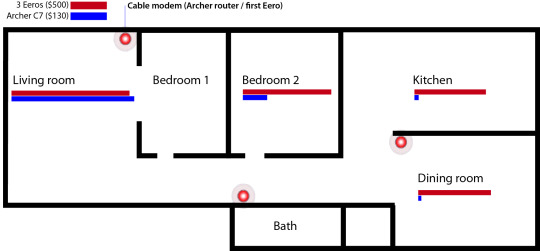
Boom: Wi-Fi coverage in every room, just as promised. The kitchen and dining room improvement? Network speeds went from 1.7 Mbps to 79 Mbps — almost miraculous.
What’s not to like
So: The Eero is small, attractive, idiot-proof, fast, and it works.
As a bonus, when someone comes over to your house, you don’t have to remember the password; you can send them a link via email or text message containing the network name and password — either for the main network, or a separate guest network that doesn’t have access to the rest of your computers.
Eero is not, however, a slam dunk for everyone. Some of the annoyances:
- To get going, you have to create an Eero account, which
includes disclosing your phone number. That seems a bit much.
- The Eero app doesn’t work when the Eeros aren’t actually
connected to the Internet. Why not? (I also found a couple of minor bugs in the app.)
- The app prominently displays a speed test. Great! Unfortunately, it never changes as you move through the house. Eero
explains that it shows the speed coming into
the house — not the speed your laptop or phone is getting within the house, which would be far more useful.

- Despite the term “mesh network,” your devices (phone, tablet, or laptop) connect to only one Eero capsule at a time. The engineering achievement here, according to Eero, is the intelligence the capsules use to hand you off from one to the next as you move through the house. OK, but it would then be nice if the app indicated which capsule you’re connected to at a given moment, particularly when you’re troubleshooting.
- The app offers three generic screens with capsule-placement
tips — “within 40 feet of each other,” “line of sight preferred,” and so on. But it
doesn’t do so interactively, tailoring
those suggestions to your house as you fiddle with
positioning. It should.
- Expert users can’t tweak the configuration settings much at all. You can’t specify the security protocol (you get WPA2, AES encryption), the channels it uses, the frequency (it offers both 2.4 and 5.0 gigahertz), and
so on. No parental controls, either.
You might also be alarmed at first that there are only two Ethernet jacks on the back of each Eero unit (plus a nonfunctional USB jack). Where are you supposed to plug in your network hard drive, printer, cellphone booster, and so on? My old Netgear router had four Ethernet jacks.

Ahh, but this is actually a benefit, at least in my setup. Because Eeros are now spread throughout the house, all of those additional network gadgets don’t have to be clumped together near the router. Two apiece can be plugged into the Eeros in less conspicuous locations.
Alternatives to Eero
To appreciate the Eero — or to solve dead-spot problems with less expense — you could certainly try some alternatives:
Get a newer router: If your current Wi-Fi router is more than a couple of years old, it doesn’t have the latest technologies and so isn’t delivering the best possible performance. Just replacing an old router could result in way better coverage.
Move your router: Your instinct might be to tuck your router out of the way, because it looks so hideous. But the truth is, positioning your router up off the ground and as centrally as possible is much better.
Get an extender: A Wi-Fi extender (or repeater) grabs the weakening signal from your router and re-broadcasts it, giving it a boost into the farther reaches of your house. But you pay a price in speed with this technique, and the extended network has a different Wi-Fi name. (Instead of My Network, it’s something like My Network_Ext.) Having to switch back and forth manually between these different networks gets old fast.
Powerline adapters: These modules plug into power outlets and then use your home’s electrical wiring as network cabling; you connect your devices through their Ethernet jacks. Unfortunately, depending on your house’s age, the quality of the wiring, number of circuits, proximity to big appliances, and so on, such networks are prone to interference and speed drops.

Multiple routers, one name: If you buy more than one router and give their networks exactly the same name and password, they automatically form a single big network. You avoid the two-network-names problem.
Apple actually advertises this technique as a feature of its AirPort base stations. (Other brands don’t always work so well.)
This setup saves you having to manually switch networks as you move. Unfortunately, it’s up to your phone, tablet, or laptop to say, “Gee, my first router signal is now so weak, I should start looking for a second one” — and, often, that doesn’t happen until you’re well into the second router’s territory.
In 802.11r networks like Eero’s, however, the routers are smart enough to tell the device, “Hey, there’s a closer router now! Make the switch!”
Rival devices: Eero is the first home 802.11r system, but others are on the way from D-Link, LinkSys, and others. Clearly, home 802.11r is going to be a thing.
The bottom line
Sometimes, time, beauty, reliability, and certainty are worth paying for. That’s why I ended up buying an Eero set for myself. My San Francisco friend also bought Eero — and canceled her electrician’s visit.
That’s two Eero systems sold already—and a very good start for the dawn of high-speed mesh networks at home.
David Pogue is the founder of Yahoo Tech; here’s how to get his columns by email. On the Web, he’s davidpogue.com. On Twitter, he’s @pogue. On email, he’s poguester@yahoo.com. He welcomes non-toxic comments in the Comments below.
Cynthia Barabe-Domingue
"A coffee and a ride always make me (h)appy," Cynthia says, the H swallowed by her Québecois accent. These are convenient preferences, as San Francisco does coffee and bikes better than most. Cynthia knows this first hand; since leaving Québec she's checked in nearly two dozen countries. "Plus, there's no snow here, so I get to bike all year. I love it."
Cynthia's studied physical education and urban planning, and has worked as a ski bum in the Rockies, a dive master in England, a bike shop girl, waitress, and restaurant manager in Canada, and a flight attendant criss-crossing North America. She went looking for herself, found a lot worth liking, saw the northern lights, and met her husband. "When I looked into what I needed to be happy in life, bicycles just kept popping up."
Cynthia has the grace and stamina of a hummingbird. She seems to float effortlessly from place to place and task to task. She works to cultivate a homecoming atmosphere for each customer, excels at pleasing the hard to please, and is often assumed to be the business owner. "It think the idea is simple, the more people on bikes the (h)ealthier our world."
Cynthia is the only staffer who has broken her neck while mountain biking.

What’s inside an Open Badge
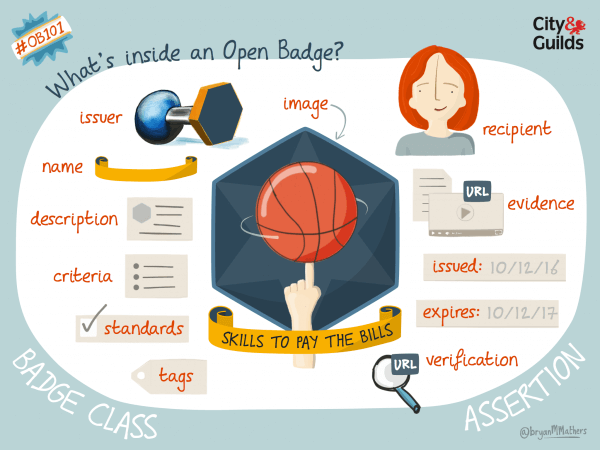
It’s easy to talk about open badges without really understanding what’s inside (it’s just a digital badge, right?) There’s actually a whole bunch of stuff inside. The badge class is like the template. All badges issued from a certain badge class will inherit those properties. The assertion relates to the recipient of the badge and all the stuff they did to earn the badge.
The post What’s inside an Open Badge appeared first on Visual Thinkery.
London Underground

The London Underground map is a design marvel. It makes your paths straight. Just looking at it lightens your load. On seeing it for the first time (as a fresh-faced 20 year-old), I thought someone had intentionally worked a bottle shape into its design (essentially the outline of the Circle line.) After attending an excellent after-hours event at London’s Cartoon Museum this week, I saw the map I’m now so familiar with, and thought I’d use the Paper53 app on my phone to fill in that bottle. The bottle does seem more pronounced as the drawing disappears. But maybe that’s just my weekend eyes…
The post London Underground appeared first on Visual Thinkery.
OER16 – Open…
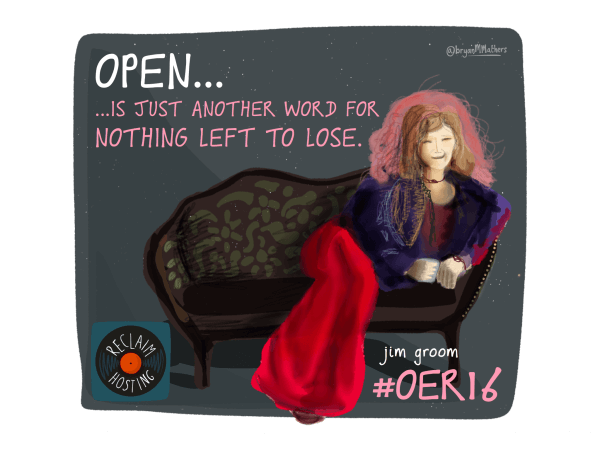
What a distraction twitter is – especially if it means drawing something. I’ll see something on twitter, have a thought, and before I know it, I’m trying to create that thought. I came across Jim Groom tweeting the title for his keynote at OER16, and I couldn’t resist.
I highly recommend tuning in…
The post OER16 – Open… appeared first on Visual Thinkery.
Continuing the Conversation About Encryption and Apple: A New Video From Mozilla
In the past week, the conversation about encryption has reached fever pitch. Encryption, Apple, and the FBI are in headlines around the world. And lively discussions about security and privacy are taking place around kitchen tables, on television, and in comment sections across the Internet.
Mozilla believes the U.S. government’s demand for Apple to circumvent their own security protections is a massive overreach. To require Apple to do this would set a dangerous precedent that threatens consumer security going forward. But this discussion is an opportunity to broaden public understanding of encryption. When people understand the role encryption plays in their everyday lives, we can all stand up for encryption when threats surface — this key issue related to the overall health of the Internet becomes mainstream.
Earlier this month — just days before the Apple story broke — Mozilla launched a public education campaign about encryption. We’re excited to continue this campaign alongside the new, robust conversations that have emerged.
Today, Mozilla is releasing the next installment in the campaign: a short film that animates encryption as a lovable character and unpacks how she works and why she’s so important.
We hope you’ll share this video with your friends and family — and then start a conversation about the issues that have come to the fore over the past week. Building grassroots support for a safe and open Internet is essential. It’s a tried and true tactic: kitchen table conversations and support from everyday Internet users helped uphold net neutrality. This is the power of the open Internet movement at work. Now, it’s time to do it again — let’s spread the word about encryption and help keep it safe.
[This blog post originally appeared on blog.mozilla.org on February 24, 2016]
The post Continuing the Conversation About Encryption and Apple: A New Video From Mozilla appeared first on Mark Surman.
Gordon Price on how Vancouver became a Livable City

A This City Life reader from Los Angeles recently contacted me to ask about Gordon Price, specifically wanting to know who he was and his role in Vancouver. This presentation that Gordon gave at Creative Mornings in 2013 instantly came to mind.
It perfectly sums up why he is an important voice in the city - he played a role in shaping Metro Vancouver as a livable region and he is an impassioned, though-provoking speaker on the subject. The presentation is worth watching to hear him explain how Vancouver became the livable region that it is today.
Some comments from the presentation include:
“Limitations and constraints provoke and inspire creativity in urban space”
“Catastrophe is often creativity’s moment. You can do things that were previously unheard of, undoable or unwanted.”
“Biggest issue in our future? The elimination of the Agricultural Land Reserve by the Prov of BC.”
“Relax, Vancouver. You can handle another bike lane.”
“When we tore down the viaducts, we saved a little piece of it…as a reminder of how we did things before.”
Side note: Gordon is currently recovering from cancer. I wish him a speedy recovery and firmly believe, just as he does, that the body can heal. As he eloquently puts it:
“The body does its amazing thing: heals, restores and rejuvenates,
sometimes at astonishing speed. Getting out of a sick bed that required
two physios now only requires two hands; a cane that was essential for
every stable step is now an unneeded accessory around the house. A walk
around Lost Lagoon that seemed immeasurably impossible a week ago now
seems to be an achievable target – perhaps next week, maybe this one.”
Five things on Friday #165
Things of note for the week ending Friday February 26th, 2016.
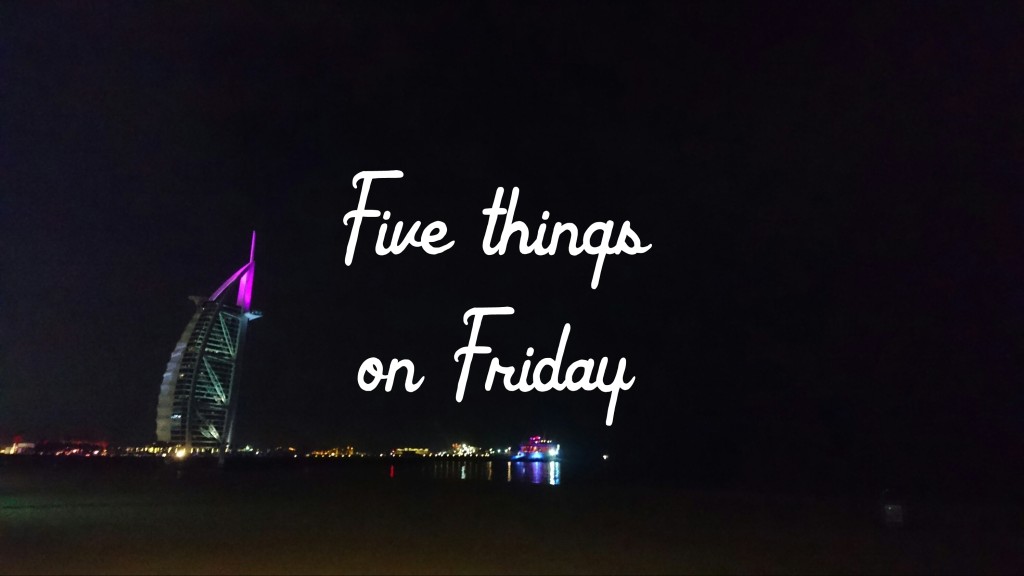
People of the Internet, hello.
Oh, that reminds me of something. Do you have to give presentations or ever have to speak publicly at all? Next time, instead of saying ‘Good morning, ladies and gentlemen’ – say instead ‘Ladies and gentlemen, good morning’.
You see, by the time you’ve finished saying the former, the crowd have only just realised you were talking to them but missed the first bit because they were looking at their phones/still talking etc. In the case of the latter, you’re addressing the crowd first and only then do you say ‘Good morning’ (or good evening, or whatever).
Try it.
And when it works, explain it to the audience too.
Right then, we have some things to get through don’t we?
Onwards!
1. #OBAMAANDKIDS

There’s so much to say about this wonderful, wonderful thing. Business Insider has a great run down of the 60 best photos, Twitter made a moment, and Time has a piece on it too.
This:
We’ll probably never truly be able to measure the impact that President Barack Obama has had on our children. As we enter the final year of his presidency, we will cherish and hold onto the great moments of progress and accomplishment. We will celebrate not just Barack Obama as a president, but also as a husband and a father. A man who has led this country with a deep love for all of it citizens, especially the ones who have yet to understand the historical meaning of the past eight years.
Beautiful.
Go browse the links above and enjoy.
*Yep, never said that before.
—___—
2. NASA’S TRAVEL DESTINATIONS
These have been around the block over the past fortnight but they’re simply too gorgeous to ignore.
Visit Mars!
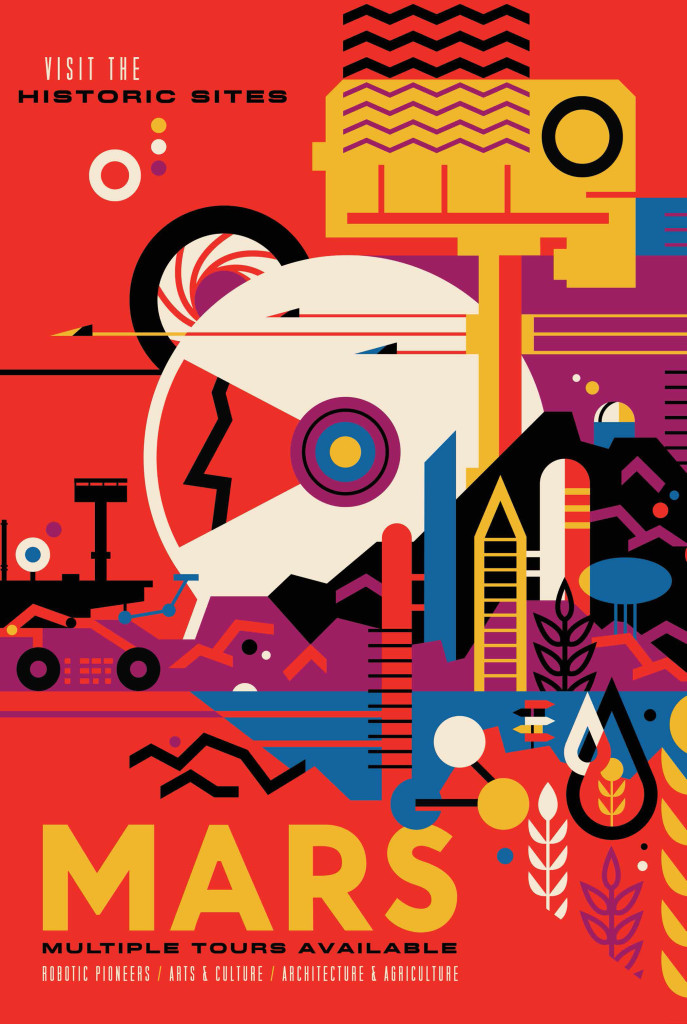
Visit Europa!
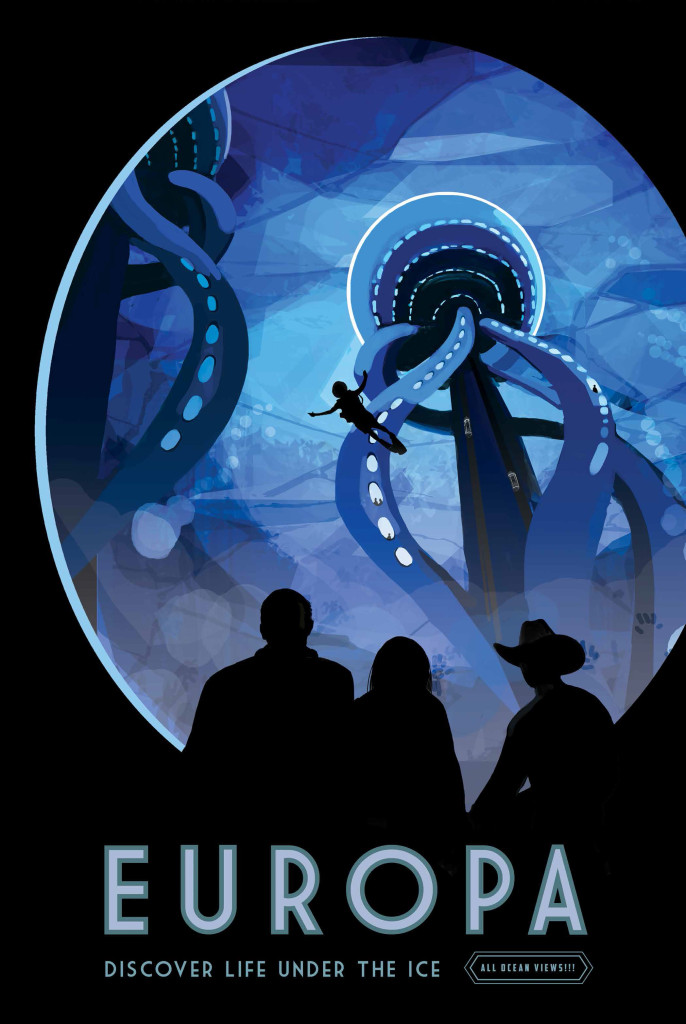
Visit HD 40307g!
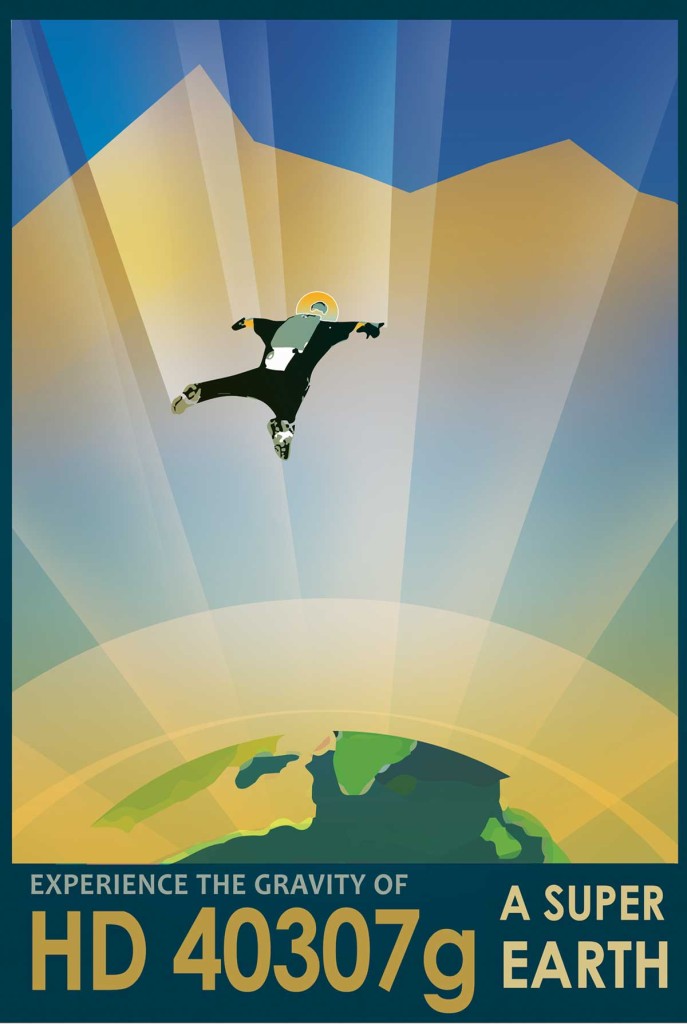
There are more (with some interesting copy too) over at the source.
_____________
3. WATCHING ROCKY II WITH MUHAMMAD ALI
This is one of my favourite reads of the week:

July 31st, 1979. And this Roger Ebert is at Muhammad Ali’s mansion to accompany him to a special screening of the newly released Rocky II.
It’s at this point in the FToF proceedings that I tend to pull out a direct quote or paraphrase something from the article I’m imploring you to read.
Not this time. No no.
This time you’re just going to have to go read it (it’s won’t be disappointed).
_—_
4. PHOTO OF THE WEEK
You’ve all seen it.
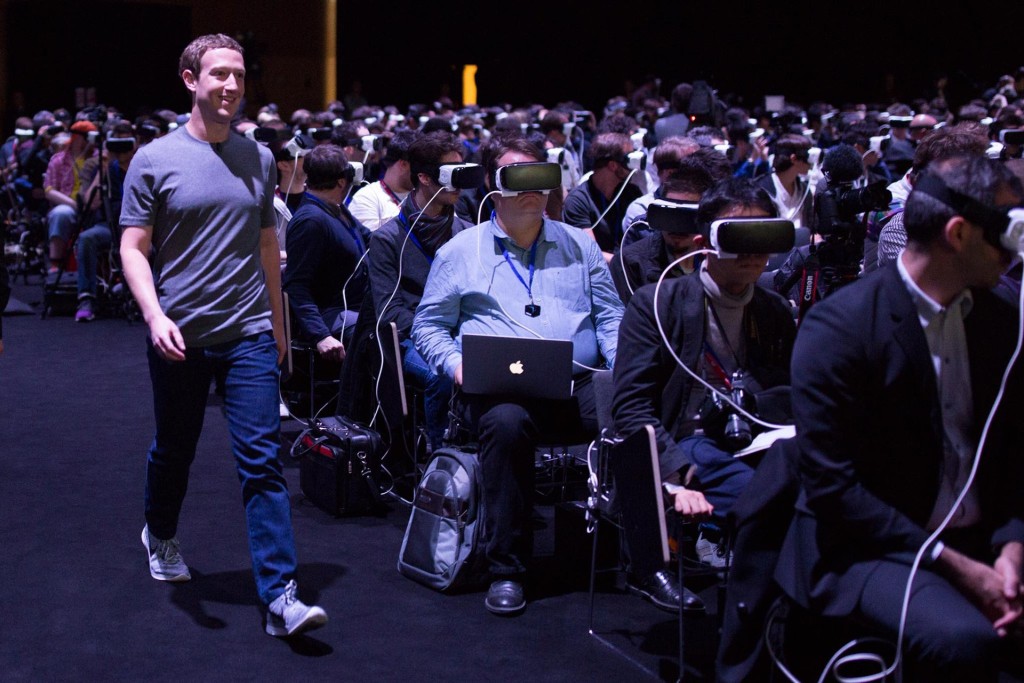
But what you may not have seen is this killer opening paragraph from The Verge:
The image above looks like concept art for a new dystopian sci-fi film. A billionaire superman with a rictus grin, striding straight past human drones, tethered to machines and blinded to reality by blinking plastic masks. Golden light shines down on the man as he strides past his subjects, cast in gloom, toward a stage where he will accept their adulation. Later that night, he will pore across his vast network and read their praise, heaped upon him in superlatives, as he drives what remains of humanity forward to his singular vision.
AMAAAAAAAAAAAAAAZING.
That is all.
_-_-_
5. CAKE OR DEATH?
This isn’t an Izzard story (but I do love this retort) – sorry. It’s just an excuse to post some photos of amazing cakes.
Don’t want death? OK – cake it is.

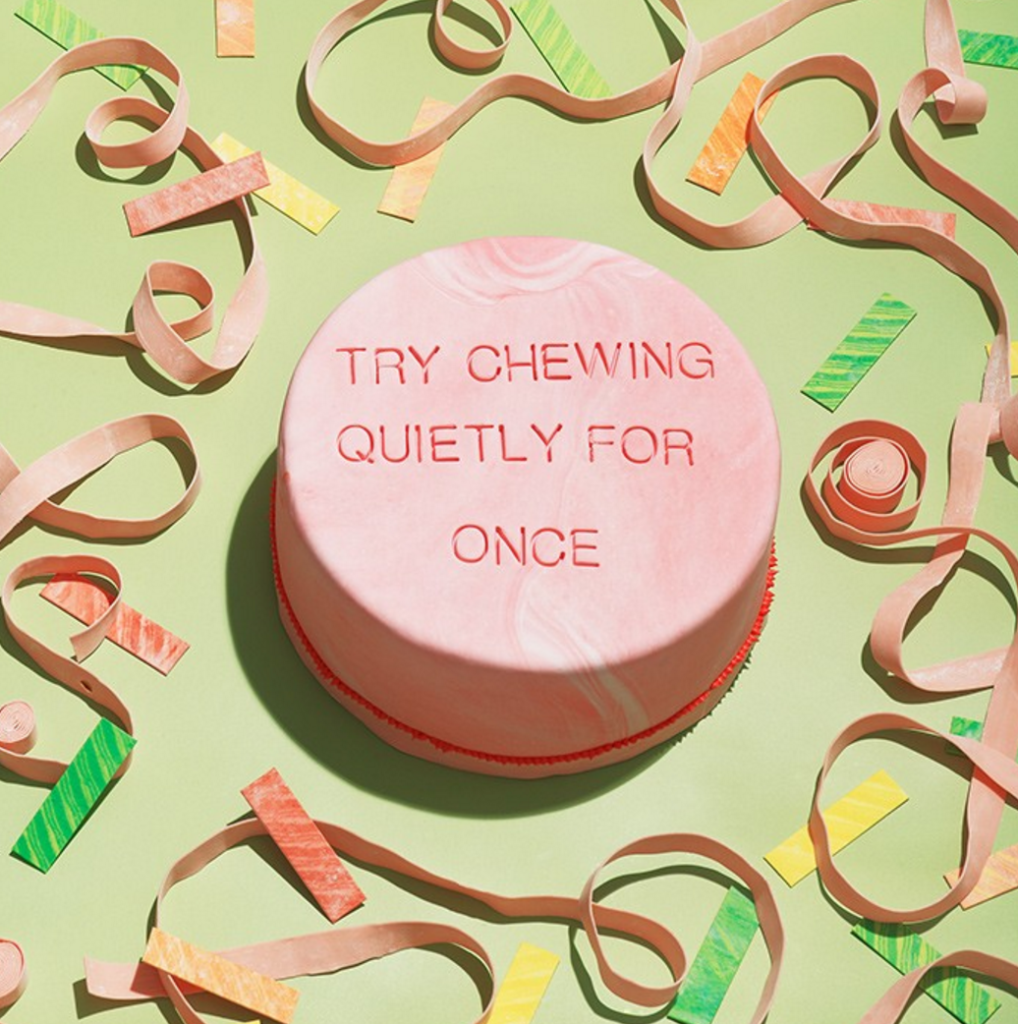

There are many more…. at the link!
_-_-___-_-_
… ./
Bonuses this week are as follows:
- Beyonce at it again? And by ‘again’ I mean, this example from ages ago. The FTC will not be happy, yo.
- Lol.
- I’m a big fan of The Awl but this week’s edition properly made me laugh.
- Remember in November (see item 2) when I said that Facebook’s new ‘immersive ad’ unit would launch in Q1 of 2016? Nailed it.
- I wrote a blog post this week about how the launch of Sky Q made me reconsider my Sky TV package, end up cancelling the whole thing, and replace it with an Amazon Fire TV. It’s one of the most popular posts of the past 12mths. If you missed it, you can find it here.
And that’s it, I’m out.
…
Anyone got a Darth Vader outfit I can borrow?
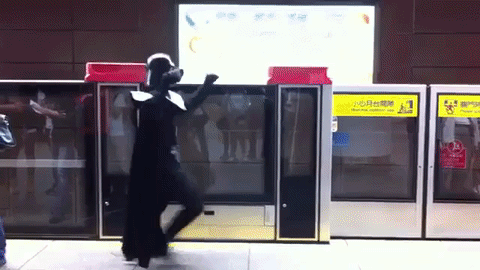
#NRC01PL Personal Learning MOOC Week 1
Jenny Mackness,
Feb 29, 2016
Jenny Mackness offers her thoughts on week one of my Personal Learning MOOC. I started the MOOC with a very gentle and gradual introduction, partially because I think it's easier for participants, and partially because I'm still learning what the OpenEdX tool can (and mostly can't) do.
[Link] [Comment]Cultural Resistance
Michael Caulfield,
Hapgood,
Feb 29, 2016
This week's off-topic link for fun week-end reading talks about what might be called 'Underground Twitter', in other words, all those peculiar Twitter things that can be really off-putting to new users, things like weird Twitter or sea-lioning. Mike Caulfield writes, "It reminds me that Twitter, despite its problems, is truly a *community* whereas Facebook is a piece of software. Twitter has a cultural learning curve and Facebook doesn’ t, but that’ s mostly because Facebook has little culture to speak of." But that's both Twitter's strength and its weakness. Sure, it's great to have community (and in-jokes, and jargon, musical and a community song). But it's limiting, it's a barrier to outsiders, and it makes it unattractive. Caulfield says "the answer to the question 'Why is Twitter so culturally complex?' is that it’ s the wrong question. It’ s Facebook that is the weird thing here, a community that doesn’ t develop an overall culture overtime." But Caulfield is wrong. Useful software doesn't develop cliques. It just doesn't.
[Link] [Comment]Mozillian profile: Dinesh
It’s my great pleasure to introduce a guest blog post today by one of our hyper-active contributors who make a difference for many users out there – Dinesh! Take a seat and listen to his story…
—-
Hello everyone,
 I’m Dinesh from India. I’ve been contributing to Mozilla since 2014. I’m a techno freak and a code lover. I am an undergraduate with a background in Electronics & Instrumentation, but I found my biggest passion to be programming and designing – both led me to learning about graphics design and front end development.
I’m Dinesh from India. I’ve been contributing to Mozilla since 2014. I’m a techno freak and a code lover. I am an undergraduate with a background in Electronics & Instrumentation, but I found my biggest passion to be programming and designing – both led me to learning about graphics design and front end development.
Being a techie, while I was exploring the world of open source, I came across Mozilla & its efforts to keep the web open. When I registered for the FSA program, I found a lot of people from India contributing to Mozilla in many ways and I became a part of the Mozilla India Community.
Since 90% of my fellow students lag in their basic technical skills and practical knowledge about programming, I thought of sharing my knowledge about open source and other technologies through our Mozilla Community. I’m the only Mozillian in my region within a 500 miles radius. This motivated me to build a new local community – Mozilla Tirupati.
Mozilla Tirupati was started by me along with a few of my friends. We took the guidance of Mozilla Reps and Regional Ambassador Leads for FSA program in India in order to build a strong community. More than 200 students registered for the FSA program as part of our Mozilla Tirupati Community and we have organized 15 events which includes a Maker Party, a Womoz Pop-up, tech talks, Hour of Code, the Fox Yeah campaign, Firefox OS App days, Mozstalls[1,2], community meetups – and more! For my huge efforts, I was recognized as FSA of the month, May 2015 & FSA Senior.
The biggest problems we faced in building our community are the resources like a good space, proper internet connections, but also the retention of new contributors. However, we are extremely happy that a couple of colleges offered their resources for us to continue our good work.
My contributions to the functional areas at Mozilla varied from time to time. I started with Webmaker by creating teaching kits and Thimble makes, but I also put effort into promoting web literacy and teaching front end development at various events. I’m proud for being recognized as a Webmaker Supermentor by Michelle Thorne. Additionally, I focused on promoting Firefox OS by developing apps for the Marketplace. Since Firefox OS apps can easily be built with HTML & JavaScript, I enjoyed developing two mobile applications about Tirupati and the Mozilla Community here. My next big area of contribution is Quality Testing, because I find it always fun and interesting – especially checking the test conditions and triaging bugs. I was awarded with Web QA Enthusiast Digital badge by Web QA Team.
After a while of contributing to these projects within Mozilla, I thought of Support Mozilla. I realised that there was a huge gap in the Knowledge Base in Telugu, my native language. I decided to change this by building a team of localizers who could help millions of people access the internet safely and easily in Telugu. We made great progress from the first day, and now I am the Locale Leader for Telugu.
At the moment we are planning to include our local SUMO team contributors in making Firefox even better and easier to use in Telugu.
As you can see through my story above, it’s easy to get started with something you like. The best thing out of everything is the global connection with many great people who always support and guide new people at any time.
Dinesh, a Proud Mozillian
—–
Would you like to write a post for the SUMO blog? Contact Michał or leave a comment under this post.
Twitter Favorites: [pw3n] Computer, give me a picture that is cartoonishly opposite of America. https://t.co/KPzU3mLgnQ
Computer, give me a picture that is cartoonishly opposite of America. pic.twitter.com/KPzU3mLgnQ
Samsung Galaxy S7 vs. iPhone 6s and Galaxy S6 edge+ preliminary camera comparison
 The 12MP camera of the Galaxy S7 has piqued everyone’s interest. After all, Samsung claims that despite the lower resolution sensor, the camera on the Galaxy S7 is better than almost any other smartphone camera in the market and rightfully so.
Continue reading →
The 12MP camera of the Galaxy S7 has piqued everyone’s interest. After all, Samsung claims that despite the lower resolution sensor, the camera on the Galaxy S7 is better than almost any other smartphone camera in the market and rightfully so.
Continue reading →
Inbox by Gmail gets even better Snooze features
 For the folks out there that get a lot of emails, but don’t always want to deal with them as they come in, the ability to make it go away until a later time is a helpful feature.
Continue reading →
For the folks out there that get a lot of emails, but don’t always want to deal with them as they come in, the ability to make it go away until a later time is a helpful feature.
Continue reading →
Everything you need to know about Mobile World Congress 2016 (Video)
Mobile World Congress started on February 21st in Barcelona, Spain with two highly anticipated smartphone launches, the LG G5 and Samsung Galaxy S7/S7 Edge.
The LG G5 is a complete redesign of the G4 and is the first modular smartphone to hit the market. Samsung on the other hand, retained the same design philosophy as last year’s S6, but made substantial refinements to its flagship device with the S7. Samsung has also brought back the often-requested micro-SD card slot, as well as IP68 waterproofing, in both the S7 and S7 edge.
The spotlight may have been mostly on the two South Korean smartphone giants, but other notable announcements came from Sony, HTC and HP. Sony announced three new Xperia phones, HTC released pricing and availability for the highly anticipated HTC Vive and HP introduced the Elite X3, a powerful Windows 10 phone that transforms into a laptop or desktop.
Watch the full video for all the latest news from the 2016 Mobile World Congress and let us know in the comments which announcement was your favourite.
Related reading: Samsung Galaxy S7 vs. LG G5: Which flagship smartphone is more promising?
2 Simple Tools Of Persuasion
We value what we have more after we have it. In psychological terms, this is known as the endowment effect. We’re also extremely loss-averse. Framing a question within a fear of loss perspective increases compliance to action.
We’re very sensitive to possible threats too. A statement positioned as a threat is likely to drive more action than one without.
You have a big arsenal of potential tools you can deploy to persuade a group and move people to action. You can rewrite most of your current messages to incorporate a fear of loss or sense of treat.
Imagine you’re trying to persuade your boss to support your engagement efforts, consider the differences in the following:
| Before the appeal | After loss / threat appeals |
| Increase retention rates | Stop losing customers to competitors |
| Improve collaboration | Stop employers wasting time and duplicating work |
| Improve knowledge sharing | Stop experts leaving and taking their expertise with them |
| Increase advocacy | Steal your competitor’s customers before they steal ours |
| Generate new leads | Find potential clients before competitors |
You can create plenty of your own examples I’m sure.
Both fear of loss and sense of threat are persuasive tools which, despite their reputation, can be used to do good. Both can be considered for any action you’re persuading people to take.
(…and if you don’t use them, your competitors certainly will.)
The Best Camera Lens Filters, Flashes, and Accessories for Taking Great Photos

If you’re a photographer looking to learn more about photography and expand your skills, make sure to grab the accessories and gear to match your vision. Some accessories, such as lenses or a hard drive to back up your photos, are great investments for almost anyone. The value of other accessories, such as color charts and photo tents, is a bit more dependent on how you want to shoot. After more than 150 hours of researching and testing different camera accessories, we’ve collected almost everything a new photographer needs to improve their photography. Once you have the gear, though, the technique is up to you.
If you want to know more about how to carry, support, and look after your camera and accessories, check out The Best Camera Bags, Straps, and Accessories to Carry With You.
LCBO plans to create online store that delivers booze right to your home
On-demand apps such as Uber, Rover and Ritual are helping shape a new industry of convenience and cost savings. The latest trend sees companies across the country offering to deliver alcohol to a person’s home. Startups such as Urbery and Thirstie are just two of the most recent examples in Toronto, and it looks like the LCBO is making delivery plans of its own.
Deep within the 2016 budget, the Government of Ontario says it plans to further modernize LCBO operations. Over the next year, the Liberal government plans to roll out Craft Beer Zones; new specialty stores that feature beverage alcohol products from around the world; as well as a new pilot program that will see 10 LCBO stores across the province start selling 12-packs of beer.
However, the main goal of the government is to build out an online store where consumers can purchase alcohol and either pickup at a select location, or more conveniently, have it delivered to their door.
“The LCBO is moving forward by creating a best-in-class e-commerce open marketplace to enhance the consumer experience and provide more opportunities for suppliers. This platform will enable beverage alcohol producers, suppliers and agents from across Canada and around the world to list their products for sale on the LCBO’s website, providing broader market access,” said Minister of Finance Charles Sousa. “It will provide consumers with access to a wider variety of products, as well as the flexibility to order online and pick up products in store or have them delivered to their home.”
There is no indication who is building out this e-commerce play, or how much it will cost. The LCBO notes it will give further details in the coming months and that it expects the platform to be operational by mid-2016.
unionmetrics: On this day of #TBT, we bring you A brief history...

On this day of #TBT, we bring you A brief history of the hashtag.
They omit the fact that I coined the term ‘hashtag’, in a blog and Twitter conversation with the innovator of the idea, Chris Messina.





